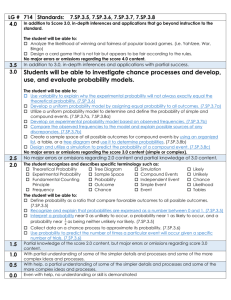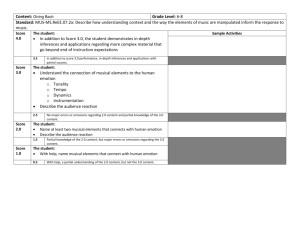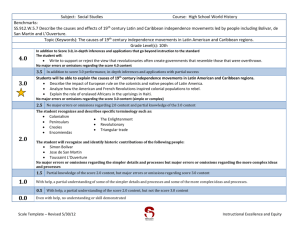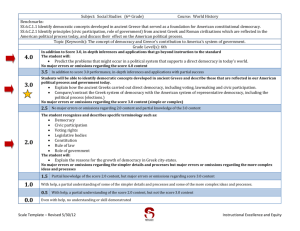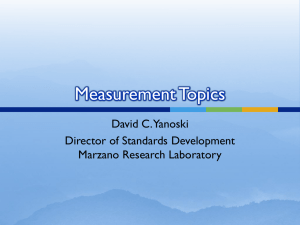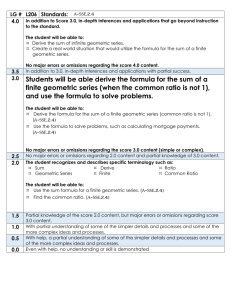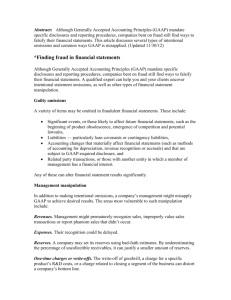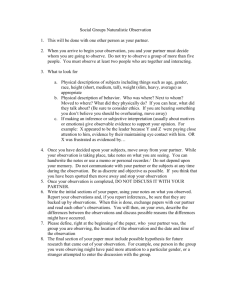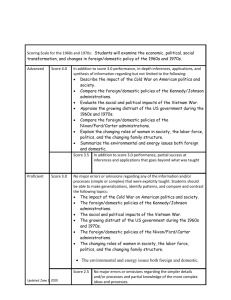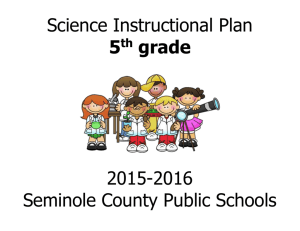Key Ideas - Seminole County Schools
advertisement
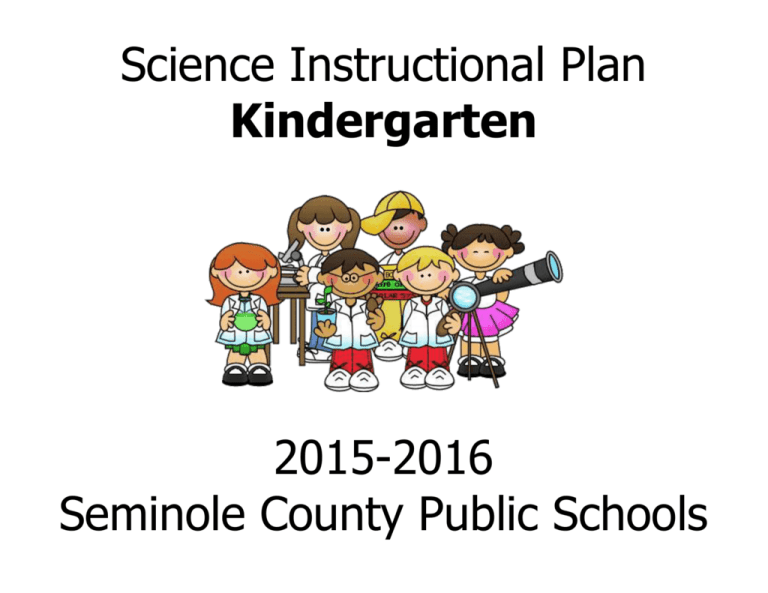
Science Instructional Plan Kindergarten 2015-2016 Seminole County Public Schools Key Changes for 2015-2016 *Resources have been reduced to just essentials. Previous Instructional Plans are still available to teachers online for additional resources. Big Books are available for teacher check-out through Dr Rachel Hallett-Njuguna. Page Keeley probes and Content Literacy examples are available for teachers through the online portal. ScienceSaurus (K-1) would need to be purchased by schools as it was not part of the district adoption (new release) *Units have been organized by Topic and standards have been grouped to support the topic. In some cases, this means an overlap of content (ex. Earth Science with Physical, Life Science with Earth, etc…) *Separate time and units for Nature of Science have been removed. The Nature of Science benchmarks have been incorporated within Topics for which they align. *Each Unit is followed by an associated Scale. Each Scale has a Level 4 Task which incorporates a Science or Engineering Practice to determine deeper understanding of content. Teachers are encouraged to allow all students to attempt the Level 4 task as it will prepare them for more rigorous standards. * Any Textbook pages or resources that are not included in the plan, are beyond content limits and standards, and should be skipped or viewed as extensions after all required content has been taught. Unit: Scientific Observations Benchmarks SC.K.N.1.2 Make observations of the natural world and know that they are descriptors collected using the five senses. SC.K.L.14.1 Recognize the five senses and related body parts. SC.K.N.1.3 Keep records as appropriate -- such as pictorial records -of investigations conducted. Fusion Resources Fusion pg 1-4 (Senses) Fusion pg 5-8 (Observations) Fusion pg 9-12 (Tools) Additional Resources CPALMS SC.K.L.14.1 Weeks 2-6 Key Ideas and Misconceptions Misconceptions ScienceSaurus pg 2-3 Page Keeley probe Senses Primary Vol 1 Science Skills Children may believe that we use only our sense of sight to observe. Some children may think that a hand lens makes an item bigger Key Ideas TE pg 21 Use Children may think that tongues are only used to taste. (ex. snakes use to smell) Doing science begins with observations At this grade, matter can be defined as equivalent to “materials,” “objects,” etc… Vocabulary Taste (mouth) Smell (nose) Touch (fingers) Hear (ears) Sight (eyes) Subject: Kindergarten Science Standard: SC.K.N.1.2 (observation using 5 senses), K.L.14.1 (5 senses), K.N.1.3 (keep records) Topic (Keywords): Scientific Observations 4.0 In addition to Score 3.0, in-depth inferences and applications that go beyond instruction to the standard The student will: Collect data through investigation of how easily objects can be identified when a sense other than sight is used. (ex. how many objects can you name just by using touch? just by using smell?) No major errors or omissions regarding the score 4.0 content 3.5 In addition to score 3.0 performance, in-depth inferences and applications with partial success The student will: be able to make observations using the five senses and recognize the related body part. 3.0 Make observations of common and unusual objects both inside and outside of the classroom. Recognize what types of observations can be made with which body part. No major errors or omissions regarding the score 3.0 content (simple or complex) 2.5 No major errors or omissions regarding 2.0 content and partial knowledge of the 3.0 content The student recognizes and describes specific terminology such as: 2.0 Taste (mouth) Smell (nose) Touch (fingers) Hear (ears) Sight (eyes) The student will: Recognize that senses can be used to make observations. No major errors or omissions regarding the simpler details and processes but major errors or omissions regarding the more complex ideas and processes 1.5 Partial knowledge of the score 2.0 content, but major errors or omissions regarding score 3.0 content 1.0 With help, a partial understanding of some of the simpler details and processes and some of the more complex ideas and processes. 0.5 With help, a partial understanding of the score 2.0 content, but not the score 3.0 content 0.0 Even with help, no understanding or skill demonstrated Unit: Properties of Matter Weeks 7-11 Fusion Resources Key Ideas and Misconceptions Benchmarks SC.K.P.8.1 Sort objects by observable properties, such as size, shape, color, temperature (hot or cold), weight (heavy or light) and texture. SC.K.N.1.1 Collaborate with a partner to collect information. SC.K.N.1.3 Keep records as appropriate - such as pictorial records -- of investigations conducted. Fusion pg 61-64 Additional Resources Big Books TE pg 161 Compare Objects Key Ideas At this stage, temperature is simply hot vs cold (no reading of thermometers is needed) TE pg 163 Writing and Math (connections) CPALMS SC.K.P.8.1 Digital Lesson Our Senses Misconceptions Students may believe that bigger objects are always heavy ScienceSaurus pg 93- 94 Digital Lab Content Literacy: How Can We Use Sorting Animals CRQ our Senses At this stage, weight is simply heavy of light (no scales/balances are needed) Vocabulary Size Shape Color Temperature (Hot, Cold) Weight (Heavy, Light) Texture Properties Observe Subject: Kindergarten Science Standard: SC.K.P.8.1 (properties), K.N.1.1 (collaborate), K.N.1.3 (keep records) Topic (Keywords): Properties of Matter 4.0 In addition to Score 3.0, in-depth inferences and applications that go beyond instruction to the standard The student will: Conduct an investigation to create a rule for how objects can be sorted. No major errors or omissions regarding the score 4.0 content 3.5 In addition to score 3.0 performance, in-depth inferences and applications with partial success The student will: be able to sort objects by observable properties (ex. size, shape, color, temperature, weight, texture). 3.0 Record temperature as hot or cold Record weight as heavy or light No major errors or omissions regarding the score 3.0 content (simple or complex) 2.5 No major errors or omissions regarding 2.0 content and partial knowledge of the 3.0 content The student recognizes and describes specific terminology such as: 2.0 Size Shape Color Temperature (Hot, Cold) Weight (Heavy, Light) Texture Properties Observe The student will: Observe properties of objects. No major errors or omissions regarding the simpler details and processes but major errors or omissions regarding the more complex ideas and processes 1.5 Partial knowledge of the score 2.0 content, but major errors or omissions regarding score 3.0 content 1.0 With help, a partial understanding of some of the simpler details and processes and some of the more complex ideas and processes. 0.5 With help, a partial understanding of the score 2.0 content, but not the score 3.0 content 0.0 Even with help, no understanding or skill demonstrated Unit: Changes in Matter Fusion Resources Benchmarks SC.K.P.9.1 Recognize that the shape of materials such as paper and clay can be changed by cutting, tearing, crumpling, smashing, or rolling. SC.K.N.1.3 Keep records as appropriate -- such as pictorial records -of investigations conducted. Fusion pg 65-68 TE pg 169 Tell Ways to Change Objects Additional Resources Big Books Weeks 12-16 Key Ideas and Misconceptions Misconceptions Some students may not consider shape and size changes as changes to matter Key Ideas At this stage, these changes do NOT need to be identified as Physical Changes or differentiated from Chemical changes Vocabulary CPALMS SC.K.P.9.1 ScienceSaurus pg 100 Cutting Tearing Crumpling Smashing Rolling Materials Subject: Kindergarten Science Standard: SC.K.P.9.1 (changing shape of materials), K.N.1.3 (keep records) Topic (Keywords): Changes in Matter 4.0 In addition to Score 3.0, in-depth inferences and applications that go beyond instruction to the standard The student will: Investigate ways to change the shape of materials. No major errors or omissions regarding the score 4.0 content 3.5 In addition to score 3.0 performance, in-depth inferences and applications with partial success 3.0 The student will: be able to recognize that the shape of materials can be changed. Identify ways to change materials by cutting, tearing, crumpling, smashing, and rolling. No major errors or omissions regarding the score 3.0 content (simple or complex) 2.5 No major errors or omissions regarding 2.0 content and partial knowledge of the 3.0 content 2.0 The student recognizes and describes specific terminology such as: Cutting Tearing Crumpling Smashing Rolling Materials The student will: Recognize the shape of materials. No major errors or omissions regarding the simpler details and processes but major errors or omissions regarding the more complex ideas and processes 1.5 Partial knowledge of the score 2.0 content, but major errors or omissions regarding score 3.0 content 1.0 With help, a partial understanding of some of the simpler details and processes and some of the more complex ideas and processes. 0.5 With help, a partial understanding of the score 2.0 content, but not the score 3.0 content 0.0 Even with help, no understanding or skill demonstrated Unit: Sound Fusion Resources Benchmarks SC.K.P.10.1 Observe that things that make sound vibrate. Fusion pg 73-76 TE pg 195 Social Studies connection SC.K.N.1.5 Recognize that learning can come from careful observation. Weeks 17-19 Digital Lesson Sound slides 1-3 (slide 4 as extension) Additional Resources Big Books Key Ideas and Misconceptions Misconceptions (none identified) Key Ideas Sound is vibrations CPALMS SC.K.P.10.1 ScienceSaurus pg 106107 PhET Sound (good visual of vibrations) Vocabulary Vibrate Sound Subject: Kindergarten Science Standard: SC.K.P.10.1 (Sound), K.N.1.5 (learning from observations) Topic (Keywords): Sound 4.0 In addition to Score 3.0, in-depth inferences and applications that go beyond instruction to the standard The student will: Develop a tool that makes sound through vibrations. No major errors or omissions regarding the score 4.0 content 3.5 In addition to score 3.0 performance, in-depth inferences and applications with partial success 3.0 The student will: be able to observe that things that make sound, vibrate. No major errors or omissions regarding the score 3.0 content (simple or complex) 2.5 No major errors or omissions regarding 2.0 content and partial knowledge of the 3.0 content The student recognizes and describes specific terminology such as: Vibrate Sound The student will: 2.0 Identify items that make sound. Recognize by sight or touch, when an object is vibrating. No major errors or omissions regarding the simpler details and processes but major errors or omissions regarding the more complex ideas and processes 1.5 Partial knowledge of the score 2.0 content, but major errors or omissions regarding score 3.0 content 1.0 With help, a partial understanding of some of the simpler details and processes and some of the more complex ideas and processes. 0.5 With help, a partial understanding of the score 2.0 content, but not the score 3.0 content 0.0 Even with help, no understanding or skill demonstrated Unit: Motion Benchmarks Weeks 20-24 Fusion Resources SC.K.E.5.1 Explore the Law Fusion pg 97-100 of Gravity by investigating (Push and Pull how objects are pulled and Gravity) toward the ground unless something holds them up. Fusion pg 94-95 SC.K.P.12.1 (Fast and Slow) Investigate that things move in different ways, such as fast, slow, etc. TE pg 246 PE SC.K.P.13.1 Observe that a Connection push or a pull can change the way an object is TE pg 247 PE moving. Connection SC.K.N.1.1 Collaborate with a partner to collect information. SC.K.N.1.3 Keep records as appropriate -- such as pictorial records -- of investigations conducted. Additional Resources Big Books CPALMS SC.K.E.5.1 SC.K.P.12.1 SC.K.P.13.1 ScienceSaurus pg 111 STEM Kits Ron’s Ramp Adventure KS2 BiteSize Pushes and Pulls Key Ideas and Misconceptions Misconceptions Students may believe that heavier objects always fall faster (provide examples of small objects that would fall as fast as large objects) Students may believe that gravity is a “thing” rather than a force Students may not recognize motions like lifting or kicking as examples of a push or pull Key Ideas All motion is the result of either a push or a pull Gravity is a force that pulls Vocabulary Gravity Push Pull Motion Subject: Kindergarten Science Standard: SC.K.E.5.1 (Gravity), P.12.1 (how things move), P.13.1 (push or pull), K.N.1.1 (collaborate), K.N.1.3 (keep records) Topic (Keywords): Motion 4.0 In addition to Score 3.0, in-depth inferences and applications that go beyond instruction to the standard The student will: Plan and conduct an investigation to compare the effects of different strengths or different directions of pushes and pulls on the motion of an object. No major errors or omissions regarding the score 4.0 content 3.5 In addition to score 3.0 performance, in-depth inferences and applications with partial success 3.0 The student will: be able to observe how things move. Observe that objects are pulled toward the ground by gravity unless something holds them up. (E.5.1) Investigate that things move in different ways. (P.12.1) Observe that a push or pull can change the way an object is moving. (P.13.1) No major errors or omissions regarding the score 3.0 content (simple or complex) 2.5 No major errors or omissions regarding 2.0 content and partial knowledge of the 3.0 content The student recognizes and describes specific terminology such as: Gravity Push Pull Motion 2.0 The student will: Recognize that everything falls down toward the ground. Recognize when an object is moving or not moving. Demonstrate a push or pull. No major errors or omissions regarding the simpler details and processes but major errors or omissions regarding the more complex ideas and processes 1.5 Partial knowledge of the score 2.0 content, but major errors or omissions regarding score 3.0 content 1.0 With help, a partial understanding of some of the simpler details and processes and some of the more complex ideas and processes. 0.5 With help, a partial understanding of the score 2.0 content, but not the score 3.0 content 0.0 Even with help, no understanding or skill demonstrated Unit: Earth, Moon, and Sun Fusion Resources Benchmarks SC.K.E.5.2 Recognize the repeating pattern of day and night. SC.K.E.5.3 Recognize that the Sun can only be seen in the daytime. SC.K.E.5.4 Observe that sometimes the Moon can be seen at night and sometimes during the day. SC.K.E.5.5 Observe that things can be big and things can be small as seen from Earth. SC.K.E.5.6 Observe that some objects are far away and some are nearby as seen from Earth. SC.K.N.1.3 Keep records as appropriate -- such as pictorial records -- of investigations conducted. SC.K.N.1.5 Recognize that learning can come from careful observation. Fusion pg 51-58 Additional Resources SC.K.E.5.2, E.5.3, E.5.4 TE pg 135 How does the day sky change? TE pg 143 Compare Day and Night Sky CPALMS Key Ideas and Misconceptions Misconceptions Some students may think that SC.K.E.5.5, E.5.6 ScienceSaurus pg 74-75 (some extra) StarLab (contact Dr Hallett-Njuguna to reserve it) Digital Lesson Day Sky (skip slide 2) Weeks 25-29 Content Literacy: Day and Night the Moon can only be seen at night Some children may think that the Earth is larger than the Sun and that the Sun and the Moon are the same size. Children may think that at night the Sun “goes out” at night like a light. Students may not realize that the Earth’s spin causes day and night Key Ideas Moon can be seen both day and night The Sun can only be seen in the daytime Day and night is caused by Earth’s rotation Sun and Moon are far away from Earth and look smaller than they are Vocabulary Sun Moon Daytime Nighttime Subject: Kindergarten Science Standard: SC.K.E.5.2 (Day and Night), E.5.3 (Sun only in day), E.5.4 (Moon at night and day), E.5.5 (size seen from Earth), E.5.6 (distance of things from Earth), K.N.1.3 (keep records), K.N.1.5 (learning from observations) Topic (Keywords): Earth, Moon, and Sun 4.0 In addition to Score 3.0, in-depth inferences and applications that go beyond instruction to the standard The student will: Research and explain why the Sun and Moon appear to be almost the same size in the sky. No major errors or omissions regarding the score 4.0 content 3.5 In addition to score 3.0 performance, in-depth inferences and applications with partial success The student will: be able to observe and recognize objects in the day and night skies. 3.0 Recognize the repeating pattern of day and night (E.5.2) Recognize that the Sun can only be seen in the daytime (E.5.3) Observe that the Moon can be seen sometimes in the day and the night. (E.5.4) Observe that things we see in the sky (like the Sun and Moon) are big or small (E.5.5) Observe that things we see in the sky (like the Sun and Moon) are far away or nearby (E.5.6) No major errors or omissions regarding the score 3.0 content (simple or complex) 2.5 No major errors or omissions regarding 2.0 content and partial knowledge of the 3.0 content The student recognizes and describes specific terminology such as: Sun Moon Daytime Nighttime 2.0 The student will: Identify the Sun and the Moon in the sky Identify daytime and nighttime No major errors or omissions regarding the simpler details and processes but major errors or omissions regarding the more complex ideas and processes 1.5 Partial knowledge of the score 2.0 content, but major errors or omissions regarding score 3.0 content 1.0 With help, a partial understanding of some of the simpler details and processes and some of the more complex ideas and processes. 0.5 With help, a partial understanding of the score 2.0 content, but not the score 3.0 content 0.0 Even with help, no understanding or skill demonstrated Unit: Animals and Plants Fusion Resources Benchmarks SC.K.L.14.2 Recognize that some books and other media portray animals and plants with characteristics and behaviors they do not have in real life. SC.K.L.14.3 Observe plants and animals, describe how they are alike and how they are different in the way they look and in the things they do. SC.K.N.1.4 Observe and create a visual representation of an object which includes its major features. SC.K.N.1.5 Recognize that learning can come from careful observation. Fusion pg 17-20 (Real vs Pretend) Big Books CPALMS SC.K.L.14.2 SC.K.L.14.3 Fusion pg 21-26 (Observing animals) Fusion pg 35-38 (Observing plants) TE pg 53 Real or Pretend TE pg 63 Sort Animals TE pg 95 How are Plants alike and different Additional Resources Weeks 30-36 Key Ideas and Misconceptions Misconceptions Some students bring misconceptions of talking animals and plants based on TV shows. Some students believe that trees and grasses are not plants Key Ideas Trees, grasses, and bushes (shrubs) are all ScienceSaurus pg 20, types of plants 29 Animals and plants do not have human Content Literacy: characteristics such as Real vs Pretend DBQ talking. Vocabulary Media Characteristics Behavior Real (real-life) Pretend TE pg 96-97 Writing and Math Connections, Take it Home! Page Keeley Probes Is it an Animal, Primary Is it a Plant, Primary Subject: Kindergarten Science Standard: SC.K.L.14.2 (real vs pretend animal and plants), L.14.3 (plant and animal characteristics), K.N.1.4 (create visuals), K.N.1.5 (learning from observations) Topic (Keywords): Animals and Plants 4.0 In addition to Score 3.0, in-depth inferences and applications that go beyond instruction to the standard The student will: Choose an animal or plant from a book, movie, or TV show and write a sentence explaining using evidence whether that animal or plant is real or not. No major errors or omissions regarding the score 4.0 content 3.5 In addition to score 3.0 performance, in-depth inferences and applications with partial success The student will: be able to compare plants and animals in real life to those in books and other media. 3.0 Recognize that some books and other media show animals and plants with characteristics they do not have in real life. (L.14.2) Describe how plants and animals are alike and how they are different. (L.14.3) No major errors or omissions regarding the score 3.0 content (simple or complex) 2.5 No major errors or omissions regarding 2.0 content and partial knowledge of the 3.0 content 2.0 The student recognizes and describes specific terminology such as: Media Characteristics Behavior Real (real-life) Pretend The student will: Observe plants and animals Identify an example of a real animal or plant and an example of that animal or plant in a book (or TV show, or movie, etc…) No major errors or omissions regarding the simpler details and processes but major errors or omissions regarding the more complex ideas and processes 1.5 Partial knowledge of the score 2.0 content, but major errors or omissions regarding score 3.0 content 1.0 With help, a partial understanding of some of the simpler details and processes and some of the more complex ideas and processes. 0.5 With help, a partial understanding of the score 2.0 content, but not the score 3.0 content 0.0 Even with help, no understanding or skill demonstrated
